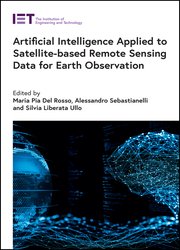 Название: Artificial Intelligence Applied to Satellite-Based Remote Sensing Data for Earth Observation Название: Artificial Intelligence Applied to Satellite-Based Remote Sensing Data for Earth Observation
Автор: Maria Pia Del Rosso, Alessandro Sebastianelli, Silvia Liberata Ullo
Издательство: The Institution of Engineering and Technology
Год: 2021
Страниц: 300
Язык: английский
Формат: True EPUB
Размер: 40,4 MB
Earth observation (EO) involves the collection, analysis, and presentation of data in order to monitor and assess the status and changes in natural and built environments. This technology has many applications including weather forecasting, tracking biodiversity, measuring land-use change, monitoring and responding to natural disasters, managing natural resources, monitoring emerging diseases and health risks, and predicting, adapting to and mitigating climate change.
This book shows how cutting-edge technologies such as Artificial Intelligence (AI), including neural networks and Deep Learning (DL), can be applied for processing satellite data for Earth observation. One of the objectives of this book is to explain how to develop a set of libraries for the implementation of artificial intelligence that could overcome some limits and encompass different aspects of research, ranging from data fusion to speckle filtering.
In particular, extraordinary developments in information and communication technologies (ICT), including the Internet, cloud computing and AI, are giving rise to radically new ways of storing, distributing and analysing Big Data about our planet. This ‘digital’ revolution is also accompanied by a ‘sensing’ revolution that is delivering unprecedented amounts of data on the state of our planet and its changes. Consequently, innovative constellations of standardised small satellites are delivering new data on our planet with high spatial resolution and high temporal frequency. These different global data sets from space lead to a far more comprehensive picture of our planet, which is complemented by data derived from millions of smart sensors connected to the Internet (referred to as the Internet of Things, or IoT) and from unmanned aerial vehicles systems. Such streams of data offer alternative possibilities not only for science but also for entrepreneurs, who are turning Big Data into new types of information-based services and businesses. However, these opportunities bring new challenges for scientists, business, data and software providers seeking to exploit the vast and diverse amount of data fully by capitalising on innovative Big Data analytics techniques such as AI.
In the first part, the authors introduce remote sensing concepts and deep neural networks and convolutional neural networks. In the second part of the book, they present the main tools used for image processing, several simulations and the data processing of specific case studies as well as the testing of related datasets. The book ends with conclusions, open questions and future works and perspectives for artificial intelligence techniques applied to future satellite missions.
The book will be of interest to researchers focusing on using machine learning tools to process remote sensing data - particularly satellite data - for Earth observation. The book can also be used as a guide for researchers in many other fields of research who are interested in using ML techniques to process data and get reliable outcomes so they can make informed decisions for their specific objectives.
Contents:
Mathematical notation
1 The rise of Artificial Intelligence (AI) for Earth Observation (EO)
1.1 Embracing external trends
1.2 The Artificial Intelligence and Deep Learning revolution
1.3 Rise of Artificial Intelligence for Earth Observation
1.4 Conclusions
2 Principles of satellite data analysis
3 Artificial intelligence, machine learning and deep learning
3.1 Introduction
3.2 Artificial intelligence, machine learning and deep learning
3.3 Supervised, unsupervised and reinforcement learning
3.4 Training and validation of a model
3.5 Cross-validation for supervised learning
3.6 Class imbalance and data augmentation
3.7 Applications
3.8 Conclusions
References
4 Artificial neural network
5 Convolutional neural networks
6 How to create a proper EO dataset
7 How to develop your network with Python and Keras
8 A classification problem
9 A generation problem
10 A filtering problem: SAR speckle filtering
11 Future perspectives and conclusions
Index
Скачать Artificial Intelligence Applied to Satellite-Based Remote Sensing Data for Earth Observation
|